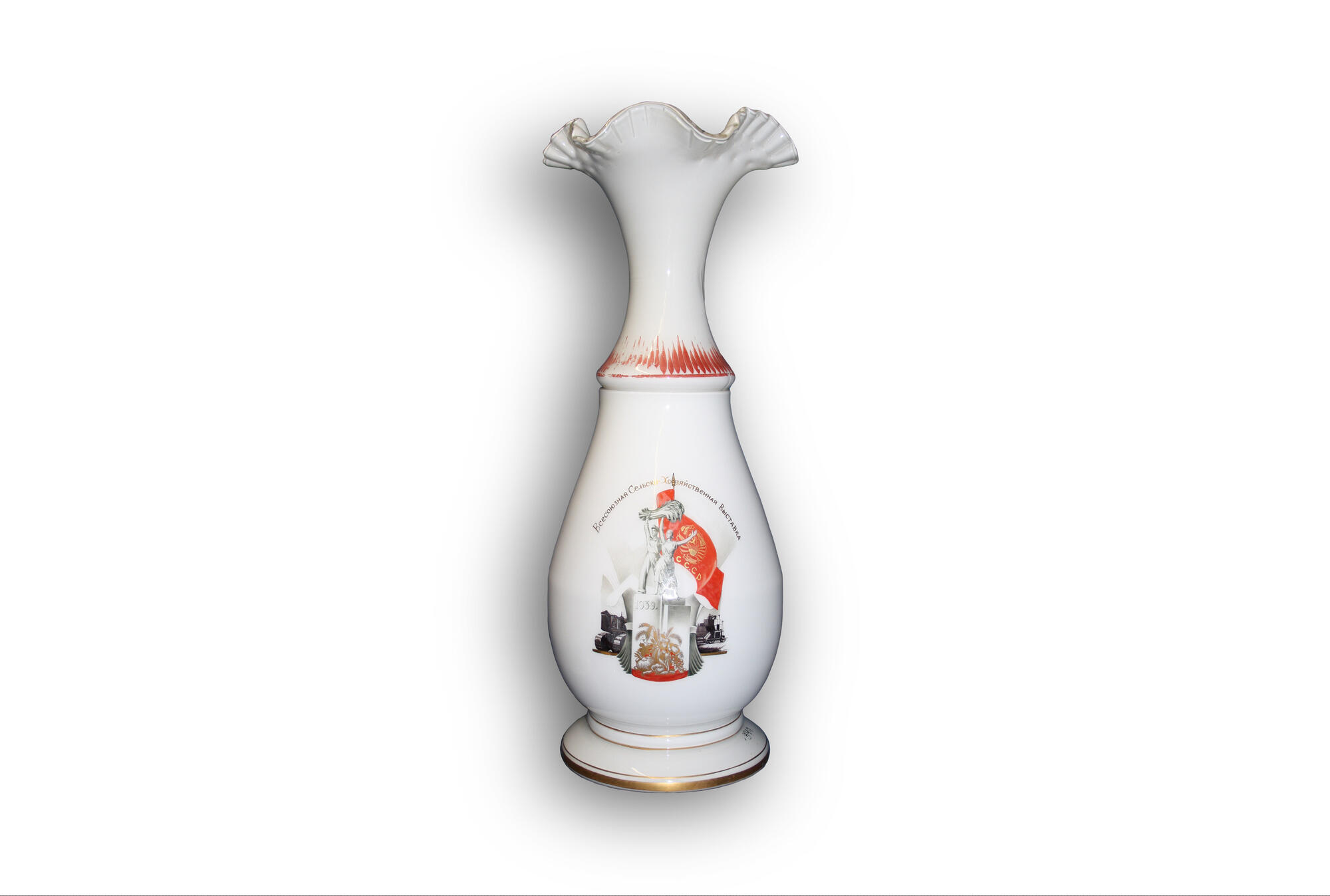When the All-Russian Agricultural Exhibition was organized in Moscow in 1938, the Dyatkovo Crystal Factory was assigned the important task of designing a number of gifts and souvenirs with thematic inscriptions and images. A series of milky glass vases with ethnic patterns was created by the Moscow artists Nina Rostovtseva and Anna Lipskaya. They designed their products based on the shapes of folk ceramic ware.
This milky glass vase was among those designed for the All-Russian Agricultural Exhibition. The vase features an image of the exhibition’s symbol — the sculpture “Worker and Kolkhoz Woman” by Vera Mukhina. At the bottom of the monument, there are images of various agricultural products. To the right, there is a caterpillar tractor, and to the left — a combine harvester. The inscription “The All-Russian Agricultural Exhibition” is painted gold above the sculptural composition. This image of the famous sculpture is distinctive in that the kolkhoz woman holds a bundle of wheat instead of the traditional sickle.
This vase is made of white or so-called milky glass, decorated with an image and gold painting. Milky glass is frosted white glass that is partially or completely opaque. It resembles porcelain and is painted using fluorine and phosphorus compounds. In the historical records of Russian factories, such glass was sometimes called “bone matter” because the opaque color was obtained by adding bone meal to the mixture for preparing glass.
The vase has a hollow base that merges sharply into an ovoid body that ends with a cylindric collar with a decorated edge. The edge of the product is decorated with a large number of wavy indentations which are added at the furnace while the glass is still hot. This is one of the most complicated decoration techniques.
There are various methods for decorating glass items with precious metals, including gold. There are such gold products as gloss, powder, liquid polishing, and leaf gold. In this case, gloss gold was used.
This milky glass vase was among those designed for the All-Russian Agricultural Exhibition. The vase features an image of the exhibition’s symbol — the sculpture “Worker and Kolkhoz Woman” by Vera Mukhina. At the bottom of the monument, there are images of various agricultural products. To the right, there is a caterpillar tractor, and to the left — a combine harvester. The inscription “The All-Russian Agricultural Exhibition” is painted gold above the sculptural composition. This image of the famous sculpture is distinctive in that the kolkhoz woman holds a bundle of wheat instead of the traditional sickle.
This vase is made of white or so-called milky glass, decorated with an image and gold painting. Milky glass is frosted white glass that is partially or completely opaque. It resembles porcelain and is painted using fluorine and phosphorus compounds. In the historical records of Russian factories, such glass was sometimes called “bone matter” because the opaque color was obtained by adding bone meal to the mixture for preparing glass.
The vase has a hollow base that merges sharply into an ovoid body that ends with a cylindric collar with a decorated edge. The edge of the product is decorated with a large number of wavy indentations which are added at the furnace while the glass is still hot. This is one of the most complicated decoration techniques.
There are various methods for decorating glass items with precious metals, including gold. There are such gold products as gloss, powder, liquid polishing, and leaf gold. In this case, gloss gold was used.

